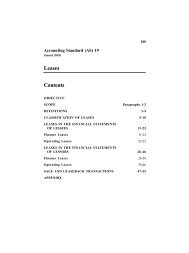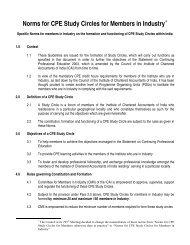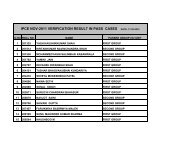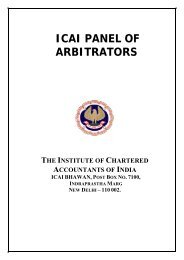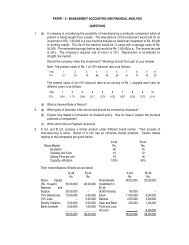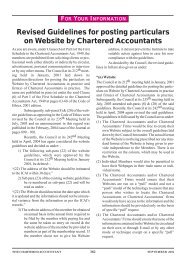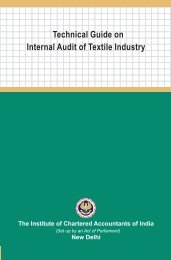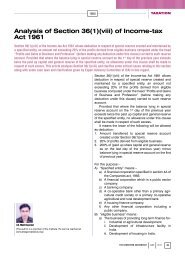The Chartered Accountant
The Chartered Accountant
The Chartered Accountant
You also want an ePaper? Increase the reach of your titles
YUMPU automatically turns print PDFs into web optimized ePapers that Google loves.
GLOBAL PERSPECTIVE<br />
<strong>The</strong> Role of the Run-Up and the Eventual Crash in Real Estate Prices, <strong>The</strong><br />
Unsustainable Euphoria that Accompanies Bubble Markets, the Securitization<br />
of Home Mortgages, and the Low Interest Rate Environment were Factors<br />
that Set the Stage for the Financial Meltdown. Nearly Every Entity that was<br />
Involved in the Subprime Crisis Bears Some Blame.<br />
crisis spread from the subprime market to engulf the<br />
broader mortgage industry and the entire banking industry<br />
in the United States, while simultaneously affecting<br />
financial institutions in several industries and<br />
governments, and threatening to bankrupt the small<br />
country of Iceland. To explain why a relatively small<br />
sector (subprime mortgages) of the US economy was<br />
able to infect the entire globe, we need to first understand<br />
what happens to a home mortgage in the<br />
United States after a consumer borrows money from<br />
a local bank to finance a home purchase.<br />
<strong>The</strong> us mortgage Industry<br />
<strong>The</strong> US mortgage industry has two sub-markets, the<br />
primary market (loans between the home buyer and<br />
the lender) and the secondary market (loans sold as<br />
investments). <strong>The</strong>re are four types of players in the<br />
secondary mortgage market, and many companies<br />
perform more than one function10 :<br />
l Originators: local, regional, and national banks<br />
and thrifts, mortgage banks, and mortgage brokers<br />
l Aggregators: large mortgage banks, financial<br />
firms, investment banks, and government<br />
sponsored entities (GSEs)<br />
l Securities dealers: broker/dealers in financial<br />
firms and investment banks that specialize in<br />
mortgages<br />
l Investors: foreign governments, pension funds,<br />
investment banks, banks, hedge funds, GSEs<br />
Prior to the 1990s, originators sold some of their<br />
mortgages to Government Sponsored Entities, such<br />
as Fannie Mae and Freddie Mac, at a higher price than<br />
the loan amount. Because banks were constrained as<br />
to the level of debt they carry on their balance sheets,<br />
selling mortgages to GSEs allowed them to originate<br />
more mortgages to home owners, thereby earning<br />
more fees and interest. Fannie and Freddie, because<br />
they were implicitly backed by the US Government,<br />
could borrow money through the bond market at<br />
rates lower than those generally available to commercial<br />
banks and thrifts. 11 Fannie was chartered by the<br />
US Congress in 1938 after the Great Depression as<br />
a way to create a secondary mortgage market, acting<br />
as an intermediary between loan originators and investors,<br />
thereby injecting liquidity and stability into<br />
the home mortgage market. Both Fannie and Freddie,<br />
also known as agencies, were further directed by<br />
Congress to focus mortgage buying efforts in underserved<br />
urban areas and low and middle income buyers.<br />
12 <strong>The</strong> monthly payments from the homeowners<br />
to service their loans were passed on by the local bank<br />
to the GSEs. <strong>The</strong> GSEs would, in turn, aggregate and<br />
package mortgages into Mortgage Backed Securities<br />
(MBS), guarantee them, and sell them to investors<br />
through securities brokers in a process called securitization.<br />
<strong>The</strong>se MBS were considered low risk and were rated<br />
highly. Investors, such as foreign governments and<br />
other institutions, bought the agency issued securities<br />
from brokers under the implicit assumption that<br />
these securities were guaranteed by the US government<br />
through the GSEs that issued them. This process<br />
of securitization allowed investors from all over<br />
the world to safely lend money to help finance home<br />
purchases in the United States and to earn a modest<br />
rate of return for their fixed-income portfolio of investments.<br />
Innovation in secondary market<br />
Investment banks that handled the bond sales for the<br />
GSEs noticed that there was an enormous appetite<br />
for MBS from investors all over the world. Moreover,<br />
some investors were willing to take on more risk but<br />
demanded higher yields than were available from the<br />
MBS issued by GSEs. Investment banks and larger<br />
mortgage financing companies looked for ways to<br />
enter this growing market and started replicating the<br />
role of GSEs, aggregating the loans in addition to<br />
simply passing them through their pipelines. <strong>The</strong>y<br />
10 Barry Nielson, CFA, “Behind <strong>The</strong> Scenes Of Your Mortgage,” Investopedia, A Forbes Digital Company, http://www.investopedia.com/articles/pf/07/secondary_mortgage.asp,<br />
accessed November 12, 2008.<br />
11 Kevin Cole, p. 5.<br />
12 <strong>The</strong> charter specifically states that Fannie should “provide ongoing assistance to the secondary market for residential mortgages (including activities relating to mortgages on<br />
housing for low- and moderate-income families involving a reasonable economic return that may be less than the return earned on other activities) by increasing the liquidity<br />
of mortgage investments and improving the distribution of investment capital available for residential mortgage financing,” Federal National Mortgage Association Charter<br />
Act, p.1, http://www.ofheo.gov/media/pdf/FNMcharter406.pdf, accessed November 12, 2008.<br />
THE CHARTERED ACCOUNTANT 1009 DECEMBER 2008



